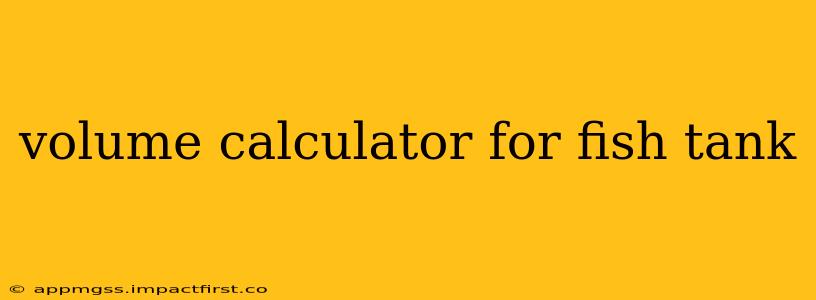Choosing the right fish tank for your aquatic friends depends on many factors, but understanding the volume is crucial. Knowing your tank's volume helps you determine how many fish you can safely keep, the amount of water changes needed, and the appropriate filtration system. This guide provides various methods for calculating your fish tank's volume, catering to different tank shapes and sizes.
How to Calculate the Volume of a Rectangular Fish Tank?
Rectangular tanks are the most common type. Calculating their volume is straightforward using a simple formula:
Volume = Length x Width x Height
Remember to use the same unit of measurement (inches, centimeters, etc.) consistently throughout the calculation. Once you have your volume, you can convert it to gallons or liters depending on your preference.
Example: A rectangular tank measures 36 inches long, 18 inches wide, and 12 inches high.
Volume = 36 inches x 18 inches x 12 inches = 7776 cubic inches
To convert cubic inches to gallons, use the conversion factor: 1 gallon ≈ 231 cubic inches
Volume in gallons ≈ 7776 cubic inches / 231 cubic inches/gallon ≈ 33.66 gallons
Important Note: Always measure the interior dimensions of your tank, not the exterior dimensions. The glass or acrylic walls add thickness.
How to Calculate the Volume of a Hexagonal Fish Tank?
Hexagonal tanks present a slightly more complex calculation. While there isn't a single simple formula, we can break it down:
- Divide the hexagon into six equilateral triangles: Imagine lines connecting the center of the hexagon to each vertex.
- Calculate the area of one triangle: The area of an equilateral triangle is (√3/4) * side². "Side" refers to the length of one side of the hexagon.
- Calculate the total area of the hexagon: Multiply the area of one triangle by six.
- Calculate the volume: Multiply the hexagonal area by the height of the tank.
This method provides a reasonably accurate volume estimate.
How to Calculate the Volume of a Cylindrical Fish Tank?
Cylindrical tanks are less common but offer a unique aesthetic. Calculating their volume involves the following formula:
Volume = πr²h
Where:
- π (pi): Approximately 3.14159
- r: Radius of the tank (half of the diameter)
- h: Height of the tank
Example: A cylindrical tank has a diameter of 12 inches and a height of 18 inches.
Radius (r) = 12 inches / 2 = 6 inches
Volume = 3.14159 x (6 inches)² x 18 inches ≈ 2035.75 cubic inches
Again, remember to convert cubic inches to gallons using the appropriate conversion factor.
How to Calculate the Volume of an Irregularly Shaped Fish Tank?
For unusually shaped tanks, precise volume calculation can be tricky. One approach is to use the water displacement method:
- Fill the tank completely with water.
- Measure the amount of water used. You can do this by carefully transferring the water into a container with known volume markings (like a large measuring jug) or use a precisely calibrated water meter.
- The amount of water used is equal to the tank's volume.
This method is the most accurate for irregularly shaped tanks.
What is the best way to measure a fish tank?
Using a flexible measuring tape is the best method for accurate measurements, particularly for curved or irregularly shaped tanks. Take multiple measurements at different points to get an average, especially for diameter measurements on cylindrical tanks.
How do I convert cubic inches to gallons?
To convert cubic inches to gallons, divide the volume in cubic inches by 231 (approximately). This is because one US gallon equals approximately 231 cubic inches.
Are there any online fish tank volume calculators?
Yes, many websites offer free online calculators for various tank shapes. Simply search for "fish tank volume calculator" to find several options. Input your tank's dimensions, and the calculator will compute the volume for you.
This comprehensive guide should equip you with the knowledge to accurately calculate the volume of your fish tank, regardless of its shape. Remember, accurate volume measurement is crucial for responsible fishkeeping.
